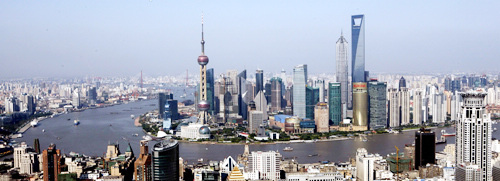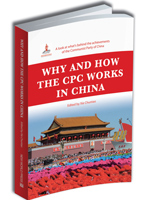|
 |
|
A bird's-eye view of Pudong New Area, a financial center and the busiest container port in Shanghai (ZHANG MING) |
 Beijing Review continues to publish edited excerpts of Why and How the CPC Works in China. Edited chapter six—How Could the CPC Make China the World's Second Largest Economy—is as follows: Beijing Review continues to publish edited excerpts of Why and How the CPC Works in China. Edited chapter six—How Could the CPC Make China the World's Second Largest Economy—is as follows:
When the 10-year "cultural revolution" (1966-76) finally came to an end in October 1976, China bade farewell to endless political campaigns. It was at that time that the Chinese people realized how poor they were. In 1978, China's GNP accounted for only 1 percent of the world's total, and its import and export volume took up only 0.8 percent of the total world trade volume. But in three decades, China's annual GDP growth rate reached 9.8 percent. China surpassed Japan in 2010 to become the second largest economy in the world.
Shortly after the "cultural revolution," Deng Xiaoping proposed that the focus of the CPC's work should be shifted to socialist modernization construction as soon as possible. Deng's proposal became the will of the decision-making body at the Third Plenum of the Eleventh Central Committee of the CPC. The meeting is regarded as the starting point of China's reform and opening up as well as of China's march toward rejuvenation. Since the plenum, China has seen a new upsurge in economic construction. The focus on economic development for more than three decades has brought considerable changes to the lives of the Chinese people. At the moment, China is the second largest trading country in the world, accounting for over 8 percent of the total world trade volume.
Deng believed that the development of the productive forces was fettered by the highly concentrated planned economy system, and decided to introduce market forces to emancipate and develop the productive forces at an appropriate time. The socialist market economy system was established in China along with the reform in rural areas, the restructuring of state-owned enterprises (SOE) and the emergence of private enterprises, which jointly propelled the emancipation and development of China's productive forces.
The household contract responsibility system with remuneration linked to output was implemented in rural areas in 1978. The rural reform aroused the peasants' productive enthusiasm, rapidly emancipated the rural productive forces and reversed the situation in which agricultural production had remained at a standstill for a long time. There were bumper harvests for years on end. The problem of food and clothing that had troubled the Chinese people for quite a long time was basically solved in just a few years.
The rural reform also boosted the development of enterprises in rural areas. These township enterprises were recognized as "an important force in the national economy" and an "important supplement to the SOEs." The Central Government gave local governments the decision-making power to promote economic development and use fiscal surpluses as incentives. The criteria for assessing government officials were based on the performance of the local economy. This policy greatly mobilized the enthusiasm of peasants and governments at the grassroots level. Explosive growth appeared in the number of people engaged in non-agricultural activities—from 28 million in 1978 to 176 million in 2003. The value of the industrial output of township enterprises accounted for one third of the total national industrial output in the mid-1990s, equal to that of the foreign-funded or state-owned economic sector. The township enterprises provided jobs for a large number of rural surplus laborers and increased market competition pressure, which stimulated the SOEs to improve their efficiency.
Compared with the rapid development in the rural areas, the urban reform process seemed slow and short of vitality. Finally, China decided to learn from the West by promoting the share-holding system in these enterprises. On September 26, 1986, the Shanghai Jing'an Securities Business Department was opened officially in Shanghai. This was the first securities market in China. The stock exchange, once regarded as a symbol of capitalism and banned for a time in China, was established again in Shanghai and Shenzhen. Now the change of securities trading data in these two cities has almost become the barometer of China's economic development.
| 